Technology in container growing has come a long way. Some may think a pot is just a pot. But in truth, today, it is not. Growers are turning to air root pruning pots for cost savings and increased revenue.
With the latest technology, container growing is one of the most economical and efficient production methods when all factors and costs are considered AND with less risk and less labor.
If you’re a commercial grower, then no matter what you are growing, it’s crucial for you to pay close attention to root structure formation. That’s because a better root structure leads to plants that grow faster and healthier. This leads to more salable plants, plants ready for sale earlier in the season, and that are better equipped to survive transplant by the consumer. For you, the grower, you’ll enjoy a growing reputation for selling healthy, vital plants—and that will lead to future sales.
So how do you create that healthy root structure? Smooth walled plastic nursery pots are commonly used—but they’re problematic because they cause root circling. When plants become root bound, a couple of issues can arise. When roots are left to circle, this can lead to an eventual decline in health. The plant will struggle to take in enough nutrients and water, which can lead to stunted growth, yellowing leaves, and a host of other issues. In some cases, if a plant is badly root bound, it may strangle and die. During transplant, consumers may be tempted to cut a badly bound root ball to encourage new root growth—and that can lead to a severe case of transplant shock.
For commercial growers, container root pruning is the best option, and there are three different techniques depending on the container: air root pruning (fabric/plastic), root entrapment (fabric), and root constriction (fabric). Which method is best for you? That will depend on a variety of factors. Read below to learn about these three types of container root pruning techniques to help you decide.
Air Root Pruning
Air root pruning relies on air to prune the roots. In other words, whether you’re using fabric air pruning pots or plastic air pruning pots (also referred to as plastic aeration containers), there must be space around the outside of the plant’s primary container. When roots grow through the pot, exposure to air dehydrates them, which causes them to drop off so that the roots self-prune themselves rather than circling until the plant becomes root-bound. That self-pruning will stimulate fibrous, lateral root growth 4-inches back from where the root is self-pruned.
With this technology, it is crucial to remember that airflow is key. One common mistake that nurseries and other growers have made is to inadvertently cut off the airflow required to prune roots. Sometimes this happens with pot-in-pot or socket pot production methods at tree farms, and sometimes it happens when space is at a premium and growers pack plants closely together to fit more into a smaller area. When something like this happens, you’ve essentially replicated the conditions of a smooth-walled plastic nursery pot. With limited airflow, roots circle inside the containers rather than self-pruning. If you rely on air root pruning to create a healthy root structure, make sure there is plenty of room around the pots for air to circulate. If that is not possible, you will want to look for fabric air pruning pots that are manufactured with a tighter weave resulting in a root entrapment technique, which provides the same root pruning benefits as air pruning, but accounts for the lack of air circulation.
Root Entrapment
Root entrapment works by trapping root tips, preventing them from growing through the fabric while stimulating those roots to create branches. This root pruning pot still relies on air pruning of roots. The difference is the roots are air pruned before penetrating the fabric sidewalls. Both this technique and the root constriction technique rely on fabric pots with a very tight fabric weave. If you’re using loose weave containers, then as mentioned above, closely packed containers or a tightly packed yard will allow roots to grow through the fabric pots causing roots to circle in a socket pot production method. Loose weave pots require plenty of air circulation around the pots for the roots to self-prune.
Because a tightly woven pot won’t really leak, you’ll retain a lot more water and more nutrients, too. Quality is key here. While it may be tempting to save on initial expenses by purchasing cheaper, lesser quality fabric pots, high-quality fabric pots will actually save you more in the long term by preventing water and nutrient loss.
Root Constriction
This method of root pruning allows small roots to grow through knit fabric base, but relies on the specially designed fabric to constrict those roots, preventing them from expanding too much. You’ll often see this technique used in conjunction with field soil. Plants are placed in fabric pots, which are situated directly onto the bare ground so that the roots can grow through the knit base fabric into the surrounding soil—but the small hole openings of the knit fabric prevent the root system from growing too large, which in turn prevents damage to the plant when it comes time to transplant. This is useful for nurseries who do want some of the plant’s roots to grow into the soil either for extra stabilization in the field, or for nutrient and water uptake. So which root pruning pot technique is best for your operation? It really depends on your production method. For pot-in-pot or socket pot growing methods, root entrapment may be the best bet—and you’ll have a choice between fabric bags or pots featuring a tight enough weave for root entrapment to happen. But if your growing operation relies on giving plants some level of access to soil, then root constriction may be the best choice. All fabric pots will provide air root pruning; however the tighter weaved fabrics will also provide nutrient and water savings. Weigh each technique carefully to choose what is right for your grow operation. If chosen correctly, the end result with all root pruning pots will be the same – a healthy, dense, fibrous root system.


